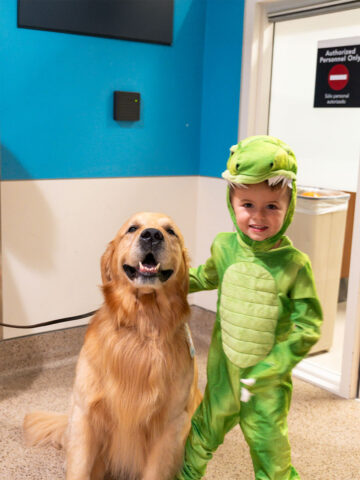Halloween can be a fun, festive time for some families — full of costumes, decorations and candy. But for some younger or more sensitive children, the crowded streets of trick-or-treating; the scary nature of some costumes and decorations; and people coming to the door for candy can be overwhelming and frightening.
To make sure their child doesn’t miss out on the fun of Halloween, what should parents do if their child is afraid?
Here, Baleska Alfaro, licensed marriage and family therapist at CHOC’s Co-occuring Clinic, offers six helpful tips to parents on how to ease into the Halloween holiday and help their children learn the difference between real and make-believe.
1. Prepare for Halloween early
For some children, really spooky costumes and decorations can be overstimulating. To help, start preparing for Halloween early. Using titrated exposure — or exposing someone slowly and carefully to feared stimuli – can reduce anxiety.
Before Halloween, try spending some time exposing your kids to the decorations and images they might see while out trick-or-treating. Visit the Halloween aisle to look at masks, costumes and decorations in small doses and in a safe environment.
Consider reading books or watching movies about Halloween and explain to your kids that although sometimes Halloween can be scary, it’s all pretend. Share some of your personal experiences with Halloween with your kids.
If you have older children who might be dressing up in a mask or scarier costume, consider letting your younger child play with their sibling’s mask and or help them get dressed or do their makeup. This might help younger ones better understand dressing up is for fun and that the costumes they see while trick-or-treating aren’t real.
2. Consider how Halloween festivities may prompt social anxiety for some children
Understandably, some children — no matter their age — may feel overwhelmed by the socialization of Halloween. Social anxiety — a persistent anxiety that arises from having to face social or public situations — can be triggered by many of the more common social events surrounding Halloween. Dressing up in costumes, walking around the neighborhood at night and asking strangers for candy – are surely out of your child’s normal routine and can provoke feelings of anxiety!
You know your child best. If trick-or-treating, passing out candy, or going to a costume party is stressful for them, consider discussing or practicing for those events before the holiday. Your child can switch off between walking up to your door and passing out candy to other siblings or friends. Perhaps you can rehearse, with your child, topics of conversation they can engage in with other children while at the party.
Or, maybe it’s best to forgo the party, trick-or-treating and passing out candy entirely. Consider scaling back your Halloween plans. Visit a community event during the day; carve pumpkins; make a festive dinner; or watch an appropriate movie together at home.
3. Acknowledge your child’s fears about Halloween
If you can see your child react to scary displays or images at stores, make sure to acknowledge and name their fears. For example, you ask them, “Did that scary clown make you feel nervous?” Then, take time to explain to your child that it’s OK to be scared, but that it’s all pretend.
Helping acknowledge your child’s fears can help not perpetuate them in the future.
4. Pick out fun, neutral costumes and decorations for Halloween
Picking out a neutral costume for your child that they’ll be comfortable in can help with the Halloween nerves. It’s also important to be flexible, your child might change their mind about their costume the day of. Have familiar dress-up clothes on hand that they can wear as Plan B.
At home, consider opting for decorations that are less spooky so your child will be comfortable.
5. Give thought to your trick-or-treating route
For younger children, it might be helpful to trick-or-treat earlier in the day. Consider going while it’s still light out; the darkness at nighttime with the added costumes, decorations and crowds might overwhelm sensitive children.
Plan your trick-or-treating route out thoughtfully. Avoid houses that might have scary decorations and avoid going too late when all the teenagers and scary costumes come out. Consider trick-or-treating with an older sibling or larger group. Someone can walk with your child up to the door in case there are spirited teenagers planning on popping up and scaring them.
6. Try to help your child overcome some of their Halloween fears, but don’t overdo it
Throughout the Halloween festivities, watch your child’s reactions. It’s important to help your child overcome their fears, but overdoing it can cause stress that might be worse in the long run. If you can tell that your child is struggling with trick-or-treating or other Halloween events, head home early. You can always try again next year!
Get more expert health advice delivered to your inbox monthly by subscribing to the KidsHealth newsletter here.
Get mental health resources from CHOC pediatric experts
The mental health team at CHOC curated the following resources on mental health topics common to kids and teens, such as depression, anxiety, suicide prevention and more.





